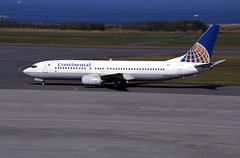 Few changes will kick in at the start
Few changes will kick in at the startIf shareholders approve merger, passengers won't see many changes at Continental and United till spring
By JENALIA MORENO Copyright 2010
Houston Chronicle
Aug. 30, 2010, 11:57PM
The government has approved Continental Airlines' merger with United Airlines, but even if the deal closes in October as expected, passengers won't notice many changes until spring.
On May 3, Houston-based Continental and Chicago-based United announced their plans to create the world's largest airline. The merged airline will be called United, have its headquarters in Chicago and be led by Continental CEO Jeff Smisek.
On Friday, the Department of Justice announced its approval of the merger. Continental had to give Dallas-based Southwest Airlines 18 of its round-trip flight slots out of Newark Liberty International Airport to address one of the merger's biggest hurdles: concerns that it would stifle competition.
Shareholders for Continental and United must still approve the merger at meetings on Sept. 17.
In an employee bulletin Monday, Continental said the two airlines expect to close the merger on Oct. 1 but will operate as two separate airlines for at least a year.
The first big change after closing day will be the move to Chicago of Smisek and other Continental managers selected to help lead the merged company. And in the months after the closing, the United name will begin to appear on Continental's planes.
But in the short term, the two airlines will run their own customer service and marketing operations, use Continental and United flight numbers, and maintain separate frequent-flier programs and airport lounges. Airport signs will stay the same.
Sometime in spring of 2011, on what the airlines have dubbed Customer Day One, the companies' reservations systems, websites and kiosks will be linked. And employees for either airline should be able to check in passengers, collect fees and give upgrades regardless of which company operates a flight.
About a year after the October closing, the merged company expects to receive its single operating certificate from the Federal Aviation Administration so the two airlines can operate as one, with employees using the same procedures and manuals.
The merged company will start to produce new uniforms for its more than 80,000 employees by early 2012, and employee benefits will be integrated sometime that year.
jenalia.moreno@chron.com

No comments:
Post a Comment